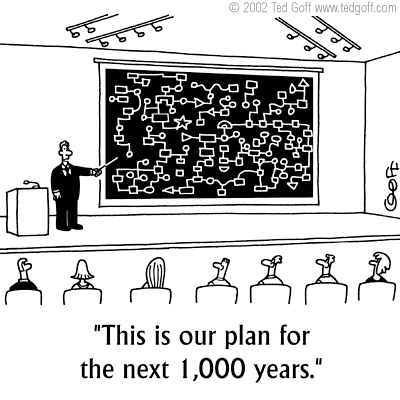
i was reminded yesterday, during a new business pitch, of the importance of narration. storytelling. the ability to narrate offers a chance to connect with one's audience. it's a chance to form a bond over an idea or point of view, or simply a story that needs to be told. when we think of narration in the context of presentation, it's the difference between steve jobs' minimilist slide design and most of our overpopulated PowerPoint slides, filled with every bullet and sub-bullet we must not forget to touch on (follow
this link from Presentation Zen for an example of Jobs vs. Gates).
i'm not using Jobs vs. Gates as the end-all example. both have very relevant styles for their respective audiences. my point, especially for creatives, would be that our presentations might be better served looking more like Jobs' visual, dramatic, minimalist presentations than the fill-to-the-gill presentations Gates uses. Jobs allows for narration.
so what can we do better? here's my list of things that will help and encourage narration.
1) Draw a line: the presentation is for storytelling, hooking, energizing and connecting with the audience. the leave-behind is for the details. the footnotes. the sources. the sub-bullets. i've never been in a presentation that lacked Q&A, whether during the presentation or after. keep yourself ready to answer the details with the leave behind near you should tough questions arise.
2) Posture: determine if the story is better told sitting or standing. oftentimes, we jump up next to the screen and go to town, losing all connection and community with the audience. in addition to a more welcoming, collaborative seated posture, sitting at the table provides resources at your finger tips.
3) Stop: remember to pause. after big points or simply between slides. make eye contact, take a breath, adjust your notes.
4) Smile: seems obvious, but smiling does two profound things in presentation. first, it makes you more enjoyable to watch and easier to connect with. second, it relaxes you, personally, and keeps any nerves at bay.
5) Question: whether you stop to make sure everyone's in agreement, or ask direct questions, this is an important and effective way to engage your audience. also provides you some breathing room and a chance to be seen as collaborative.
6) Bring props: don't rely on the presentation slides to provide the stickiness your audience needs to stay engaged.
7) Go multimedia: there's no excuse not to incorporate some tunes, videos and images into the presentation. easy as pie from a technical standpoint and extremely rewarding for your audience.
8) Dress comfortably: if you're not comfortable in your clothes, your audience won't be comfortable looking at you.
9) Control your own destiny: or at least your own slide progression. there's little more annoying than watching two people try to coordinate slide progression. this is especially important if you're using bullets and treating the slide content like talking points. you'll need to move naturally, at your own pace. if you're worried about how to technically do this, or are the only person presenting, simply take your wireless mouse and click through. it's bulkier than a slick presentation remote, but the benefit of staying away from the computer is worth it.
10) End on a high note: sometimes, actually many times, your presentation peaks before the last slide. oftentimes, it peaks before you have to get to the budget/estimate slides. figures. if you're able. make a hard stop at this point. relish in the excitement, bond over the victory, then transition into the remainder. plowing through a positive moment can cost you momentum and lose the good impression/vibe you worked so hard to achieve.
hope this helps. it's certainly a work in progress from my standpoint. but a quick reminder of these certainly help me focus. and remember the importance of narrating, not talking at, my audience.
Labels: presentation













